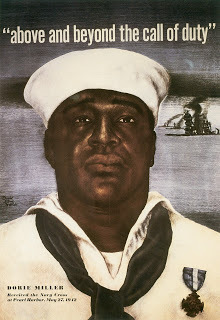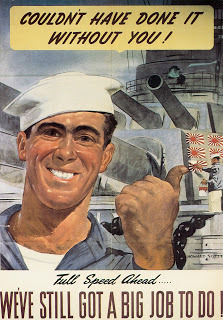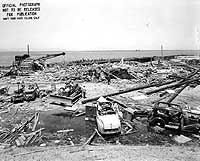Sarah Sundin's Blog, page 500
October 31, 2011
Port Chicago - Desegregation of the Navy
 In the worst Home Front disaster of World War II, an explosion at the Naval Magazine in Port Chicago, California on July 17, 1944 killed 320 men, of whom 202 were black. The tragedy was followed by a work stoppage and a controversial mutiny trial. This sent ripples of change through the segregated armed forces.
In the worst Home Front disaster of World War II, an explosion at the Naval Magazine in Port Chicago, California on July 17, 1944 killed 320 men, of whom 202 were black. The tragedy was followed by a work stoppage and a controversial mutiny trial. This sent ripples of change through the segregated armed forces. These events are included in my third novel, Blue Skies Tomorrow. Previous blog posts discussed the situation in the armed forces and at Port Chicago, the explosion, the work stoppage, and the mutiny trial. Today's post looks at the change that resulted.
Public Outrage
The explosion and mutiny trial were heavily publicized, at the Navy's request. While the purpose was to discourage further insubordination in the ranks, the publicity backfired, exposing the segregated and discriminatory practices in the Navy. A great outcry went up in the black community, but many whites were appalled as well.
Further Discord
The difficult and humiliating conditions for blacks in the armed forces caused more strife and violence. On July 31, 1944, 75 black members of the 1320th Army Engineers refused to work on an airfield on Oahu. They were convicted of mutiny on February 1, 1945. Christmas Eve and Day on Guam were marked by an ugly race riot that killed one black and one white Marine. Forty-three blacks were court-martialed and sentenced; no whites were arrested. And in March 1945, one thousand black Seabees at Port Hueneme, California engaged in a two-day hunger strike to protest discrimination.
Proponents of Change
The black sailor had a friend in the new Secretary of the Navy, James V. Forrestal, appointed by the president on May 19, 1944 after the death of Frank Knox on April 28. Forrestal found that Admiral Ernest King, Chief of Naval Operations and Commander-in-Chief of the United States Fleet, agreed that integration was right and necessary. In March 1945, Forrestal asked Lester Granger of the National Urban League to serve as his advisor. Forrestal liked Granger's tactics. Rather than promoting fairness and rights, Granger stressed that desegregation increased security, production, and administrative efficiency - arguments that carried greater weight with commanders.
[image error] Gradual Changes
Ironically, on August 9, 1944, the same day the survivors of the Port Chicago Explosion refused to load ammunition, Forrestal informed the commanders of 25 fleet auxiliary ships that they would be assigned black sailors to be fully integrated on their crews. In this experimental change, the black sailors were found to be accepted and efficient crewmembers. As a result, all auxiliary ships were fully integrated on March 6, 1945.
In January 1945, a pamphlet went out to naval officers, encouraging ratings and promotions be made for blacks on the same basis as for whites. The pamphlet also warned against the use or racial epithets.
In response to the Port Chicago incident, on February 21, 1945, the Navy limited blacks working at ammunition depots to no more than 30 percent of the work force. An argument that proved effective was that dispersing blacks prevented collective action like riots and strikes.
Specialist training schools had quietly been integrating since 1943, simply due to the inefficiency of maintaining separate schools. In June 1945, all Navy training camps were desegregated and in July 1945, the Navy opened submarine and aviation pilot training to blacks as well.
Strides were made within the Navy for black women as well. In October 1944, the WAVEs (Women Accepted for Volunteer Emergency Service) opened recruitment for black women, and in March 1945, the Navy Nurse Corps also opened to blacks.
Results
Progress in the Navy was significant but slow. By the end of the war, 5.3 percent of naval personnel were black, double the prewar percentage but still less than half the percentage of the population. Only 60 black officers served in the Navy, up from zero before the war. Seventy black women served as WAVEs, and four black women served in the Navy Nurse Corps. Before the war, blacks were only allowed to serve as steward's mates. By the end of the war, blacks held 67 different ratings but 40 percent still served as steward's mates.
 Full Integration
Full IntegrationWork continued in the Navy after the war. On February 27, 1946, without fanfare, the Bureau of Naval Personnel issued Circular Letter 48-46 which prohibited all segregation in assignments, ratings, ranks, ships, facilities, and housing. Not until 1948 were the rest of the armed forces completely integrated. While the Navy had been the most segregated service before the war, it became the first integrated service branch. The events surrounding the Port Chicago Explosion played a significant role in these landmark changes.
Sources:
MacGregor, Morris J. Jr. Integration of the Armed Forces 1940-1965. Washington DC: Center of Military History, United States Army, 1985. On U.S. Army Center of Military History website. Accessed 2 October 2011. http://www.history.army.mil/books/integration/IAF-FM.htm
Allen, Robert L. The Port Chicago Mutiny. Berkeley CA: Heyday Books, 2006.
Published on October 31, 2011 13:57
Today in World War II History
70 Years Ago—Oct. 31, 1941: Destroyer Reuben James sunk by U-boat off Iceland—first US warship lost, 115 killed. Mount Rushmore completed after 14 years of work. Movie premiere of Disney's Dumbo.
Published on October 31, 2011 03:00
October 30, 2011
Today in World War II History
70 Years Ago—Oct. 30, 1941: German siege of Sevastopol begins. USO Camp Shows established to entertain troops overseas. Charles Lindbergh holds isolationist America First rally for 20,000 at Madison Square Gardens. Col. David N.W. Grant designated first "Air Surgeon."
Published on October 30, 2011 03:00
October 29, 2011
Today in World War II History
70 Years Ago—Oct. 29, 1941: Gen. Walter Kuntze named commander of German 12th Army.[image error]
Published on October 29, 2011 03:00
October 28, 2011
Today in World War II History
70 Years Ago—Oct. 28, 1941: Movie premiere of How Green Was My Valley in New York City.[image error]
Published on October 28, 2011 03:00
October 27, 2011
Book Beat - A Quaker Christmas
 Do you love Christmas but find the stress of the season overwhelming? I sure do. Christmas novella collections offer a sweet remedy - short, uplifting stories to refresh your love of the holiday but without demanding too much time.
Do you love Christmas but find the stress of the season overwhelming? I sure do. Christmas novella collections offer a sweet remedy - short, uplifting stories to refresh your love of the holiday but without demanding too much time.A Quaker Christmas offers four such stories, each following a nineteenth-century Quaker woman.
In A Crossroad to Love by Lauralee Bliss, Mary Hall helps at her parents inn, but is disturbed by their newest guest, Silas Jones, who mocks the faith of the Friends. And yet he's so attractive. A lame horse and a family emergency prolong Silas's stay, and Mary learns the cause of Silas's animosity - but can she help him find healing?
In Simple Gifts by Ramona Cecil, young widow Lucinda Hughes is blessed by her former husband's best friend, Will Davis, who quietly watches over her. But Will's growing love for Lucinda is checked by her diminishing faith and the concerns of family. Can Lucinda see behind Will's quiet facade to see his worth, and can her faith be renewed?
Pirate of My Heart by Rachael Phillips was my favorite of the lot, mostly because of Phillips's trademark humor. Keturah Wilkes wears a red shawl. Good Quaker girls do not wear bright colors. Keturah chases her shawl into the river and is rescued by handsome boatman Henry Mangun. Just as Keturah bucks the traditions of her family, Henry bucks his family's traditions - the traditions of river pirates. Will Henry break free? Will Keturah be dazzled by Henry's dashing older brother? Or will she see Henry's worth?
Equally Yoked by Claire Sanders tells of Susanna Griffith, who is not a Quaker but has just married into the Friends faith. When her husband is away from the farm, Susanna finds herself involved with her in-laws' Underground Railroad activity. Susanna must decide whether to adopt her new family's ways and risk everything to help an escaped slave.
The four stories were each satisfying. A light thread linked the stories. My only gripe about the collection is that the stories were not arranged in chronological order - why? - so that the linking thread was more difficult to see. However, the collection was as delightful and refreshing as the gingerbread cookies the four women share.[image error]
Published on October 27, 2011 05:00
Today in World War II History
70 Years Ago—Oct. 27, 1941: President Roosevelt asks Congress to allow arming of US merchant ships (after Kearney torpedoed 10/17). Nazis kill 300 elderly Jews with exhaust fumes in vans, the first killings by this method.
Published on October 27, 2011 03:00
October 26, 2011
Today in World War II History
70 Years Ago—Oct. 26, 1941: Germans break into Crimean peninsula.
Published on October 26, 2011 03:00
October 25, 2011
Today in World War II History
70 Years Ago—Oct. 25, 1941: US condemns Nazi practice of killing innocent civilians in reprisal for partisan activities.
Published on October 25, 2011 03:00
October 24, 2011
Port Chicago - the Mutiny Trial
 In the worst Home Front disaster of World War II, an explosion at the Naval Magazine in Port Chicago, California on July 17, 1944 killed 320 men, of whom 202 were black. The tragedy was followed by a work stoppage and a controversial mutiny trial. This sent ripples of change through the segregated armed forces.
In the worst Home Front disaster of World War II, an explosion at the Naval Magazine in Port Chicago, California on July 17, 1944 killed 320 men, of whom 202 were black. The tragedy was followed by a work stoppage and a controversial mutiny trial. This sent ripples of change through the segregated armed forces. These events are included in my third novel, Blue Skies Tomorrow. Previous blog posts discussed the situation in the armed forces and at Port Chicago, the explosion, and the work stoppage. Today's post covers the mutiny trial, and next week we'll look at the aftermath.
Mutiny Trial
On August 9, 1944, 258 survivors of the explosion refused to load ammunition at Mare Island Naval Depot in Vallejo, California. After the threat of a charge of mutiny on August 11, fifty of these men still refused to load ammunition and were charged with mutiny.
A General Court Martial was convened by Adm. Carleton Wright, commander of the 12th Naval District with a seven-member court led by Rear Adm. Hugo Osterhaus to act as judge and jury. The prosecution was led by Lt. Cdr. James Coakley. The defense team was led by Lt. Gerald Veltmann and consisted of five additional lawyers who each handled the cases of ten defendants.
The trial was held in a Marines barracks on Yerba Buena Island (also known as Treasure Island) in San Francisco Bay.
[image error] Prosecution
On September 14, 1944 the trial opened. Coakley argued that a strike was mutinous in time of war. He dismissed the defendants' claims, stating, "What kind of discipline, what kind of morale would we have if men in the United States Navy could refuse to obey an order and then get off on the grounds of fear?"
The questioning of the defendants was loaded with racial language, and the prosecutors often disparaged the men's honesty, especially when their spoken statements contradicted their earlier statements—although the men had complained that the transcriptions were inaccurate. One defendant had refused to load ammunition because he'd broken his wrist the day before the work stoppage and was wearing a cast. Coakley replied that "there were plenty of things a one-armed man could do on the ammunition dock."
Defense
Veltmann quoted the official legal definition of mutiny: "a concerted effort to usurp, subvert, or override authority," and argued that the men had never tried to seize command and therefore, were not guilty of mutiny. Since direct orders had not been given to each man, they could not be guilty of disobeying orders. The defense chronicled the discriminatory conditions at Port Chicago, the psychological effects of the explosion and cleaning up body parts, and the unchanged conditions they faced at Mare Island.
Publicity
The Navy encouraged the press to cover the trial, and the NAACP sent their chief counsel, Thurgood Marshall (the future Supreme Court justice), who sat through twelve days of the trial. On October 10, Marshall held a press conference and stated that the prosecution acted in a prejudicial manner. On October 17, he issued a statement deriding the conditions in the Navy and specifically at Port Chicago. He believed the men were guilty of the lesser charge of insubordination and did not meet the legal definition of mutiny.
Verdict
On October 24, 1944, after deliberating for 80 minutes, the court convicted all 50 defendants of mutiny, including the man with the broken wrist and two others who had never loaded ammunition previously for medical reasons. All 50 men received 15-year sentences, and at the end of November they were imprisoned at Terminal Island Disciplinary Barracks in San Pedro, California.
Further Legal Action
On November 15, Admiral Wright reviewed the court's findings and adjusted the sentences to 8-15 years. On April 3, 1945 Thurgood Marshall filed an appeals brief to the Judge Advocate General's office in Washington DC. Concerned about hearsay evidence, the Secretary of the Navy asked the court to reconvene. They did so on June 12, 1945, but upheld the sentences.
After the war was over, the sentences were reduced. In September 1945, one year was lopped off each man's sentence, and in October the sentences were reduced to two years for all the men with good conduct and three for those with bad conduct. In January 1946, the Navy released all but three of the men—one remained for bad conduct and two in the hospital. The men stayed in the Navy and eventually received honorable discharges, but the felony convictions remained on their records.
Sources:
Allen, Robert L. The Port Chicago Mutiny. Berkeley CA: Heyday Books, 2006.
The Articles of War. Washington DC: United States War Department, approved 8 September 1920. http://www.ibiblio.org/hyperwar/USA/ref/AW/index.html, accessed 23 October 2011.
Department of the Navy. Articles for the Governance of the United States Navy, 1930. Washington DC: United States Government Printing Office, 1932. On Naval Historical Center website, updated 17 December 2001. http://www.history.navy.mil/faqs/faq59-7.htm, accessed 23 October 2011.
Marshall, Thurgood. "Statement on the Trial of Negro Sailors at Yerba Buena, September 24, 1944." On Organization of American Historians website: www.oah.org/pubs, printed 20 November 2007.
Published on October 24, 2011 05:00



